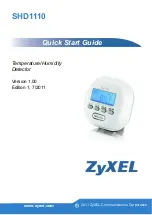
1-4
Cisco uBR924 Router Hardware Installation Guide
OL-0338-01 (3/2000)
Chapter 1
Product Overview
Cisco uBR924 Cable Access Router Description
The download of the DOCSIS configuration file usually takes only a few seconds and is done every time
the Cisco uBR924 router reboots. The download of the software image can take several minutes to
complete, during which time network connectivity is not available. However, the software image must
be downloaded only once, until the subscriber needs to be updated with a new or updated image.
The next section, “Initial Power-On and Provisioning,” explains this process. See the Cisco uBR924
Cable Access Router Software Configuration Guide for a description on how to download a software
image and configuration file to a Cisco uBR924 router installed in the field.
Initial Power-On and Provisioning
The router ships from the Cisco factory ready to work in a DOCSIS-compliant bridging data-only mode.
However, before the router can transmit traffic, the CMTS at the headend must properly provision the
router as follows:
•
The appropriate service must be purchased from the cable system. If certain features, such as VoIP
support or IPSec data encryption, are desired, a license for the appropriate Cisco IOS software
image must also be purchased.
•
When the router is first brought online, the CMTS at the headend downloads a DOCSIS
configuration file to the router. This file—which is a binary file that must be in the format required
by the DOCSIS specification—configures the router for the appropriate level of services and sets
other parameters as needed.
•
At this point the router is completely configured for basic DOCSIS operations, but if additional
features beyond those in the default Cisco IOS software image are desired, the DOCSIS
configuration file can also specify that the router should download another Cisco IOS image from
the CMTS.
•
To customize the router’s configuration further, the DOCSIS configuration file can also specify a
Cisco IOS configuration file that the CMTS should download to the router. This second
configuration file is an ASCII text file that contains the Cisco IOS commands needed to configure
the router.
Note
The CMTS Cisco uBR924 router downloads the DOCSIS configuration file each time it is
powered on, but it downloads the Cisco IOS image (if needed) and Cisco IOS
configuration file (if needed) only once when the router is initially brought online.
However, a new configuration file or image can be downloaded whenever necessary, such
as when the cable service offers new services or subscribers upgrade their services.
To ensure that subscribers obtain the exact services they have ordered, the Cisco uBR924 router arrives
from the Cisco factory with a unique identifier (UID) that consists of a serial number and MAC address.
These factory-assigned values are on a label at the bottom of the router; for convenience, these values
are also in a barcode label that can be easily scanned for easy entry into the service provider’s
provisioning and billing system.
Using the MAC address of the router as the key, the CMTS downloads the DOCSIS configuration file
and Cisco IOS image that will provide the services that this particular subscriber has purchased. Service
technicians at the headend typically create a number of standard configuration files to match the range
of services offered by the provider; these configuration files can be created manually or with tools
provided by Cisco Systems for this purpose.
The following sections describe the initial power-on and provisioning sequence in more detail, as well
as the requirements that must be met by both the router and the CMTS before provisioning can succeed.
















































